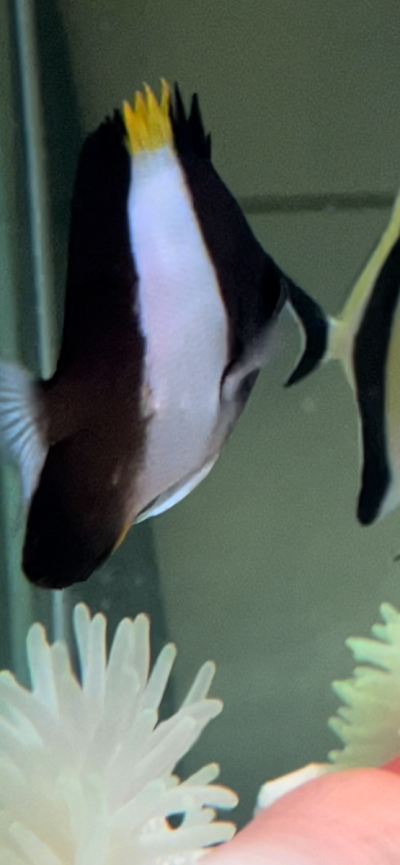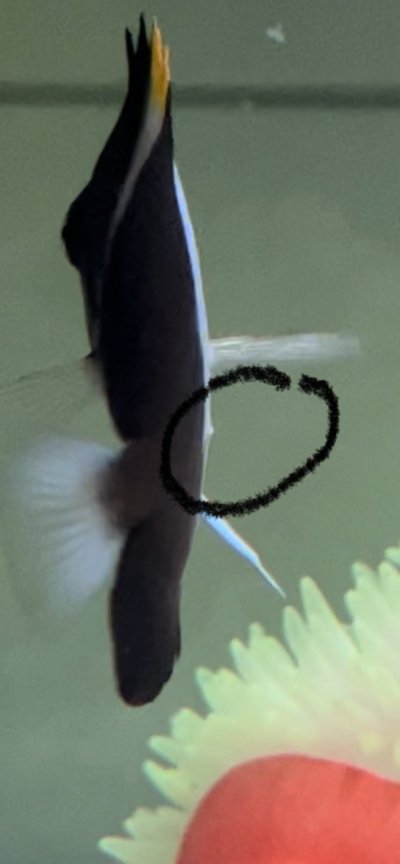Navigation
Install the app
How to install the app on iOS
Follow along with the video below to see how to install our site as a web app on your home screen.
Note: This feature may not be available in some browsers.
More options
You are using an out of date browser. It may not display this or other websites correctly.
You should upgrade or use an alternative browser.
You should upgrade or use an alternative browser.
White spots on zoster butterfly fish
- Thread starter chrisreeftang
- Start date
-
- Tags
- ich outbreak
- Tagged users None
Welcome to Reef2Reef!
Could just be random bumps. The spots seem too large and raised up to by ich trophonts. I can see by the anemones in the shot that it is in a display. This genus of butterflyfish is REALLY prone to developing Neobenedenia flukes - while these spots are not a primary symptom of that, the glass surfing can be. If the fish hasn't been treated for them, it very likely is infected.
Jay
Could just be random bumps. The spots seem too large and raised up to by ich trophonts. I can see by the anemones in the shot that it is in a display. This genus of butterflyfish is REALLY prone to developing Neobenedenia flukes - while these spots are not a primary symptom of that, the glass surfing can be. If the fish hasn't been treated for them, it very likely is infected.
Jay
Upvote
0
Hey jay Thanks for the response , I’m going to look it up and see how to treat it. Can that spread ?Welcome to Reef2Reef!
Could just be random bumps. The spots seem too large and raised up to by ich trophonts. I can see by the anemones in the shot that it is in a display. This genus of butterflyfish is REALLY prone to developing Neobenedenia flukes - while these spots are not a primary symptom of that, the glass surfing can be. If the fish hasn't been treated for them, it very likely is infected.
Jay
Upvote
0
Hey jay Thanks for the response , I’m going to look it up and see how to treat it. Can that spread ?
Yes - there are many fish that can contract this disease. However, I would not jump into a whole tank treatment unless you confirm the infection first, through a 5 minute FW dip, or seeing cloudy eyes in the fish. Here is a write up I've done on it:
Neobenedenia melleni (eye flukes)
These are relatively large (up to 8 mm), egg-laying worms that live on the skin or eyes of marine fishes.
Symptoms
Neobenedenia infections peak slowly; there may be no symptoms for weeks after you acquire a fish. Eventually, as the flukes multiply and grow in size, they begin to cause symptoms of disease.
The first obvious symptom may be slightly cloudy eyes, caused by the transparent fluke feeding on the eye tissue and eliciting a tissue reaction. This gives this worm the common name of “eye fluke,” although it is unknown whether these worms actually prefer to feed on eye tissue, or whether that is just where they first become apparent.
As the infection becomes more serious, the fish will “flash,” their skin color will become dull, their fins may become tattered, and they just generally get a “scruffy” look to them. Rapid breathing due to stress, possible secondary infection, and then death follow if treatment is not begun.
Diagnosis
The best means of diagnosis is to give the fish a five-minute freshwater dip. Not only does this knock back the infection by killing the adult parasites, but even a casual look at the bottom of the dip container afterwards will help to positively identify this disease. The worms turn whitish and fall to the bottom. Many aquarists mistake these for scales that were dislodged from the fish. However, looking at these “scales” under a dissecting microscope, or even a hand lens, will soon show them for what they are—dead worms.
Sometimes a fish’s history can help diagnosis at least the potential for this disease. Angelfishes and butterflyfishes are especially prone to Neobenedenia infections, so any of these fish that have been housed at an import facility that doesn’t prophylactically treat for trematodes stand a very good chance of being infected.
Treatment
Many people suggest using a freshwater dip as a treatment for all incoming fish. The two drawbacks to this are 1) the dips are not 100% effective (and do not harm the fluke eggs) and 2) newly acquired fish often do not stand up well to the added stress of a freshwater dip when they first arrive.
Neobenedenia eggs can take 14 (or longer?) to hatch as motile larvae called oncomiracidium. Additionally, the eggs have sticky tendrils that attach them securely to all manner of objects in an aquarium. There is some merit to the idea of keeping a treatment tank free of substrate and siphoning the bottom regularly in order to remove some of these unhatched eggs. There have been reports that Lysmata cleaner shrimp feed on these eggs, rendering them non-viable. However, it is unlikely that in a normal aquarium, with many other food choices, that cleaner shrimp will markedly reduce their numbers.
Any successful treatment for these worms must be undertaken in stages. The first treatment kills off the adult worms (but this won’t kill the eggs), and the subsequent treatments kill off the juvenile worms after they have all hatched but before any of them have matured and begun to lay eggs of their own. Due to variables in timing, it is virtually impossible to accomplish this in only two treatments.
Whole-tank formalin baths at 166 ppm for one hour will eliminate the adult flukes from an aquarium but not the eggs. Because this type of treatment has no residual effect, the treatment may need to be repeated every two weeks for two or three more times. Experience in public aquarium exhibits has shown that this method rarely clears a tank completely of this pest.
A better alternative is a Praziquantel treatment at 4 ppm, followed by a 50% water change after 48 hours, then a second treatment 9 to 10 days later, followed by another 50% water change 48 hours later.
At the aquarium I was the curator at, we noticed that multiple Praziquantel treatments on the same system, over months to years, required higher and higher doses, combined with increased frequency of the treatments in order to maintain effectiveness. Eventually, the praziquantel was simply no longer effective. One supposition was that the target parasites were building an immunity to the drug. That seemed unlikely as genetic change in multi-cellular organisms typically takes longer to happen (as opposed to drug-resistant bacteria that can develop resistance in short order). We wondered then, what could render Praziquantel so ineffective on repeat doses?
Subsequent research indicates that bacterial degradation of the Praziquantel (Thomas et-al, 2016) is the process at work. Their study concluded that while Praziquantel is stable for over two weeks in sterile marine aquarium water, when dosed in working systems, it degrades below detectable limits in just nine days. A subsequent dose on the same system showed a reduction in Praziquantel in less than 48 hours. The presence or absence of fish in the system did not affect this rate of degradation. The natural bacterial population of the aquarium actually works to eliminate Praziquantel from the water.
Barrett L. Christie, a public aquarium curator, has researched a variety of treatment methods and has struck upon one that is highly effective. The treatment is relatively simple; in a quarantine system, the fish are exposed to hyposalinity (low salinity) for 30 days. Exactly how low of a salinity is the variable that needs to be controlled. Some species of fish do not tolerate lower salinities, yet if the salinity is not reduced enough, the parasite population is only reduced, not eradicated. Barrett has hit upon a workable value of 17 parts per thousand, a bit less than half the salinity of normal seawater (this equates to a specific gravity of around 1.013). Using a target of 16 ppt for 35 days is better, as it ensures that any errors in salinity measurement or timing won’t affect the treatment. Obviously, most invertebrates cannot be present during this sort of treatment. Sharks and some rays cannot tolerate it either. Assuming the fish are healthy in all other respects, you begin this treatment by lowering the salinity to the target value over 24 to 48 hours. During the low salinity treatment, water quality must be monitored closely, especially pH. Be aware that some other diseases, notably Uronema and Amyloodinium thrive at lower salinities. Luckily, another common scourge, marine ich, Cryptocaryon irritans, is also inhibited by low salinity. After 35 days, the salinity is gradually raised back to normal. It is imperative to perform this change back to normal seawater very slowly. While marine fish tolerate a drop in salinity very well, their kidneys have more difficulty adjusting as the salinity is raised. Never return fish to normal salinity faster than 72 hours, and don’t make large changes at one time.
Jay
Upvote
0
Similar threads
- Replies
- 8
- Views
- 117
- Replies
- 6
- Views
- 197
- Replies
- 14
- Views
- 150
- Replies
- 16
- Views
- 404
- Replies
- 32
- Views
- 713















